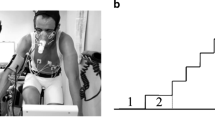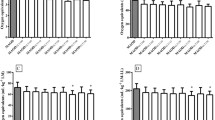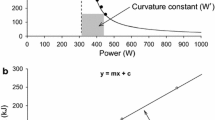Summary
The development of simple, noninvasive tests of work capacities, underpinned primarily by anaerobic metabolism, proliferated in the early 1970s. A 30-second maximal cycle test developed at the Wingate Institute initiated efforts to develop work tests of anaerobic capacities. Such tests can be developed using any ergometer which simulates competitive conditions and enables an accurate determination of mechanical work output. A 10-second all-out test is commonly used to measure maximal work output generated primarily via the hydrolysis of high-energy Phosphagens (i.e. the alactic work capacity). In contrast, a variety of constant-load and all-out tests of anaerobic (alactic plus lactic) work capacity have been proposed. It has been suggested that all-out tests provide more information about physiological capabilities and are easier to apply than constant-load tests. The optimal duration for an all-out test of anaerobic work capacity is proposed at 30 seconds, a duration which may also provide the basis for the development of accurate field tests of anaerobic capacity. There is evidence that the y-intercept of the maximal work-derivation regression is a valid work estimate of anaerobic capacity in athletes, although its utility is undermined by the number of tests required for its derivation.
Similar content being viewed by others
References
Green S, Dawson BT. Measurement of anaerobic capacities in humans: definitions, limitations and unsolved problems. Sports Med 1993; 15(5): 312–27
Maison GL, Broeker AC. Training in human muscle working with and without blood supply. Am J Physiol 1941; 132: 390–404
Vandewalle H, Peres G, Monod H. Standard anaerobic exercise tests. Sports Med 1987; 4: 268–89
Lakomy HKA. An ergometer for measuring the power generated during sprinting. Br J Sports Med 1985; 19: 81–4
Cheetham ME, Boobis LH, Brooks S, et al. Human muscle metabolism during sprinting. J Appl Physiol 1986; 61(1): 54–60
Nevill ME, Boobis LH, Brooks S, et al. Effect of training on muscle metabolism during treadmill sprinting. J Appl Physiol 1989; 67(6): 2376–82
di Prampero PE. Energetics of muscular exercise. Rev Physiol Biochem Pharmacol 1981; 89: 144–222
Hirvonen J, Rehunen S, Rusko H, et al. Breakdown of high-energy phosphate compounds and lactate accumulation during short supramaximal exercise. Eur J Appl Physiol 1987; 56: 253–9
Hultman E, Greenhaff PL, Ren J-M, et al. Energy metabolism and fatigue during intense muscular contraction. Biochem Soc Trans 1991; 19: 347–53
Szogy A. The influence of speed and strength characteristics on the anaerobic capacity of adolescent cyclists. In: Oseid S, Carlsen K-H, editors. Children and exercise XIII; international series on sport sciences. Champaign: Human Kinetics, 1989: 67–73
Boobis LH. Metabolic aspects of fatigue during sprinting. In: MacLeod D, Maughan R, Nimmo M, editors. Exercise: benefits, limits and adaptations. London: E & FN Spon, 1987: 116–43
McKenna MJ, Green RA, Shaw PF, et al. Tests of anaerobic power and capacity. Aust J Sci Med Sport 1987; 19(2): 13–7
Seresse O, Ama PFM, Simoneau J, et al. Anaerobic performances of sedentary and trained subjects. Can J Sport Sci 1989; 14(1): 46–52
Simoneau JA, Lortie G, Boulay MR, et al. Tests of anaerobic alactacid and lactacid capacities: description and reliability. Can J Appl Sports Sci 1983; 8(4): 266–70
Telford RD. Specific performance analysis with air-braked ergometers. J Sports Med 1982; 22: 349–57
Freeman P, Sandstrom R. Kayaking. In: Draper J, Telford R, editors. Sport specific guidelines for the physiological assessment of the elite athlete. Canberra: Australian Coaching Council, 1989: 53–66
Gillam I, Ellis L. Cross Country Skiing. In: Draper J, Telford R, editors. Sport specific guidelines for the physiological assessment of the elite athlete. Canberra: National Sports Research Program, Australian Coaching Council, 1989: 1–20
Beleastro AN, Campbell CJ, Bonen A, et al. Adaptation of human skeletal muscle myofibril ATPase activity to power training. Aust J Sports Med 1981; 13(4): 93–7
Jacobs I, Esbjornsson M, Sylven C, et al. Sprint training effects on muscle myoglobin, enzymes, fiber type, and blood lactate. Med Sci Sports Exerc 1987; 19(4): 368–74
Jansson E, Esbjornsson M, Holm I, et al. Increase in the proportion of fast-twitch muscle fibres by sprint training in males. Acta Physiol Scand 1990; 140: 359–63
Thorstensson A, Sjodin B, Karlsson J. Enzyme activities and muscle strength after ‘sprint training’ in man. Acta Physiol Scand 1975; 94: 313–8
Esbjornsson M, Sylven C, Holm I, et al. Fast twitch fibres may predict anaerobic performance in both females and males. Int J Sports Med 1993; 14(5): 257–63
Cunningham DA, Faulkner JA. The effect of training on aerobic and anaerobic metabolism. Med Sci Sports 1969; 1: 65–9
Schnabel A, Kindermann W. Assessment of anaerobic capacity in runners. Eur J Appl Physiol 1983; 52: 42–6
Paterson DH, Cunningham DA, Bumstead LA. Recovery O2 and blood lactic acid: longitudinal analysis in boys aged 11 to 15 years. Eur J Appl Physiol 1986; 55: 93–9
Berg A, Keul J. Comparative performance diagnostics of anaerobic exertion in laboratory and field exercise of decathletes. Int J Sports Med 1985; 6: 244–53
Houston ME, Thomson JA. The response of endurance-adapted adults to intense anaerobic training. Eur J Appl Physiol 1977; 36: 207–13
Parkhouse WS, McKenzie DC, Hochachka PW, et al. Buffering capacity of deproteinized human vastus lateralis muscle. J Appl Physiol 1985; 58(1): 14–7
Medbø JI, Sejersted OM. Acid-base and electrolyte balance after exhausting exercise in endurance-trained and sprint-trained subjects. Acta Physiol Scand 1985; 125: 97–109
Thomson JM, Garvie KJ. A laboratory method for the determination of anaerobic energy expenditure during sprinting. Can J Appl Sports Sci 1981; 6(1): 21–6
Green HJ, Houston ME. Effect of a season of ice hockey on energy capacities and associated function. Med Sci Sports 1975; 7: 299–303
Green S. Anthropometric and physiological characteristics of South Australian soccer players. Aust J Sci Med Sports 1992; 24(1): 3–7
McKenzie DC, Parkhouse WS, Hearst WE. Anaerobic performance characteristics of elite Canadian 800 meter runners. Can J Appl Sports Sci 1982; 7(3): 158–60
Rhodes EC, Mosher RE, McKenzie DC, et al. Physiological profiles of the Canadian Olympic soccer team. Can J Appl Sports Sci 1986; 11(1): 31–6
Hermansen L, Medbø JI. The relative significance of aerobic and anaerobic processes during maximal exercise of short duration. In: Marconnet P, Poortmans HJ, L Hermansen, et al., editors. Medicine and sport sciences: physiological chemistry of training and detraining. Basel: Karger, 1984: 56–67
Medbø JI, Mohn AC, Tabata I, et al. Anaerobic capacity determined by maximal accumulated O2 deficit. J Appl Physiol 1988; 64(1): 50–60
Carlson J, Portier B. Running. In: Draper J, Telford R, editors. Sport specific guidelines for the physiological assessment of the elite athlete. Canberra: Australian Coaching Council, 1989: 91–6
Crielaard JM, Merken P, Franchimont P, et al. Evaluation de la capacité anaerobic lactique en athlétisme. Med Sport 1986; 60: 239–44
Debruyn-Prevost P, Sturbois X. Physiological response of girls to aerobic and anaerobic endurance tests. J Sports Med 1984; 24: 149–54
Hebbelinck M. Ergometry in physical research. J Sports Med 1969; 9: 69–79
Heyters C, Poortmans JR. Evaluation de la capacité anaerobique: étude de la reproductibilité et de la validité d’un test de laboratoire. Can J Appl Sports Sci 1977; 2: 183–7
Hill AV. Muscular movement in man. New York: McGraw-Hill, 1927
Scherrer J, Samson M, Paleologue A. Etude du travail musculaire et de la fatigue: Données ergometriques obtenués chez l’homme. J Physiol Paris 1954; 46: 887–916
Monod H, Scherrer J. The work capacity of a synergic muscular group. Ergonomics 1965; 8: 329–38
Whipp BJ, Huntsman DJ, Storer TW, et al. A constant which determines the duration of tolerance to high-intensity work. Fed Proc 1982; 41: 1591
Moritani T, Nagata A, Devries HA, et al. Critical power as a measure of physical work capacity and anaerobic threshold. Ergonomics 1981; 24: 339–50
Bulbulian R, Wilcox AR, Darabos BL. Anaerobic contribution to distance running performance of trained cross-country athletes. Med Sci Sports Exerc 1986; 18(1): 107–13
Gaesser GA, Wilson LA. Effects of continuous and interval training on the parameters of the power-endurance time relationship for high-intensity exercise. Int J Sports Med 1988; 9: 417–21
Housh DJ, Housh TJ, Bauge SM. A methodological consideration for the determination of critical power and anaerobic work capacity. Res Q Exerc Sport 1990; 61(4): 406–9
Jenkins DG, Quigley BM. The y-intercept of the critical power function as a measure of anaerobic work capacity. Ergonomics 1991; 34(1): 13–22
Poole DC, Ward SA, Whipp BJ. The effects of training on the metabolic and respiratory profile of high-intensity cycle ergometer exercise. Eur J Appl Physiol 1990; 59: 421–9
Jenkins DG, Quigley BM. The influence of high-intensity exercise training on the Wlim-Tlim relationship. Med Sci Sports Exerc 1993; 25(2): 275–82
Nebelsick-Gullett LJ, Housh TJ, Johnson GO, et al. A comparison between methods of measuring anaerobic work capacity. Ergonomics 1988; 31: 1413–9
Vandewalle H, Kapitaniak B, Grun S, et al. Comparison between a 30-s all-out test and a time-work test on a cycle ergometer. Eur J Appl Physiol 1989; 58: 375–81
Hughson RL, Orok CJ, Staudt LE. A high velocity treadmill running test to assess endurance running potential. Int J Sports Med 1984; 5(1): 23–35
Wakayoshi K, Ikuta K, Yoshida T, et al. Determination and validity of critical velocity as an index of swimming performance in the competitive swimmer. Eur J Appl Physiol 1992; 64: 153–7
Jenkins DG, Quigley BM. Blood lactate in trained cyclists during cycle ergometry at critical power. Eur J Appl Physiol 1990; 61: 278–83
Jenkins DG, Quigley BM. Endurance training enhances critical power. Med Sci Sports Exerc 1992; 24(11): 1283–9
Green S, Dawson BT, Goodman C, et al. The y-intercept of the maximal work-duration relationship and anaerobic capacity in cyclists. Eur J Appl Physiol. In press
Medbø JI, Burgers S. Effeets of training on the anaerobic capacity. Med Sci Sports Exerc 1990; 22(4): 501–7
Bell GA, Wenger HA. The effect of one-legged sprint training on intramuscular pH and non-bicarbonate buffering capacity. Eur J Appl Physiol 1988; 58: 158–64
Cadefau J, Casademont J, Grau JM, et al. Biochemical and histochemical adaptation to sprint training in young athletes. Acta Physiol Scand 1990; 140: 341–51
Roberts AD, Billeter R, Howald H. Anaerobic muscle enzyme changes after interval training. Int J Sports Med 1982; 3: 18–21
Poole DC. Letter to the editor-in-chief. Med Sci Sports Exerc 1986; 18(6): 703–4
Medbø JI, Tabata I. Relative importance of aerobic and anaerobic energy release during short-lasting exhausting bicycle exercise. J Appl Physiol 1989; 67(5): 1881–6
Medbø JI, Tabata I. Anaerobic energy release in working muscle during 30 s to 3 min of exhausting bicycling. J Appl Physiol 1993; 75(4): 1654–60
Peronnet F, Massicotte D. Table of nonprotein respiratory quotient: an update. Can J Sport Sci 1991; 16(1): 23–9
Craig NP, Pyke FS, Norton KI. Specificity of test duration when assessing the anaerobic lactacid capacity of high-performance track cyclists. Int J Sports Med 1989; 10(4): 237–42
Fry RW, Morton AR. Physiological and kinanthropometric attributes of elite flatwater kayakists. Med Sci Sports Exerc 1991; 23(11): 1297–301
Jacobs I. Influence of carbohydrate stores on maximal human power output. In: MacLeod D, Maughan R, Nimmo M, et al., editors. Exercise: benefits, limits and adaptation. London: E& FN Spon, 1987: 104–15
Symons JD, Jacobs I. High-intensity exercise performance is not impaired by low intramuscular glycogen. Med Sci Sports Exerc 1989; 21(5): 550–7
Rohrs DM, Mayhew JL, Arabas C, et al. The relationship between seven anaerobic tests and swim performance. J Swimming Res 1990; 6(4): 15–9
Vandewalle H, Peres G, Heller J, et al. All-out anaerobic capacity tests on cycle ergometers. Eur J Appl Physiol 1985; 54: 222–9
Ayalon A, Inbar O, Bar-Or O. Relationship among measurements of explosive strength and anaerobic power. In: Nelson RC, Morehouse CA, editors. Biomechanics IV, International series on sport sciences. Baltimore: University Press, 1974: 572–7
Patton JF, Murphy MM, Frederick FA. Maximal power outputs during the Wingate anaerobic test. Int J Sports Med 1985; 6: 82–5
Katch V, Weltman A, Martin R, et al. Optimal test characteristics for maximal anaerobic work on the bicycle ergometer. Res Q 1977; 48(2): 319–27
Denis C, Linossier MT, Dormois D, et al. Power and metabolic responses during supramaximal exercise in 100-m and 800-m runners. Scand J Med Sci Sports 1992; 2: 62–9
Katch VL, Weltman A. Interrelationships between anaerobic power output, anaerobic capacity and aerobic power. Ergonomics 1979; 22: 325–32
Withers RT, Sherman WM, Clark DG, et al. Muscle metabolism during 30, 60 and 90 s of maximal cycling on an air-braked ergometer. Eur J Appl Physiol 1991; 63(5): 354–62
Bar-Or O, Dotan R, Inbar O. A 30-second all-out ergometric test — its reliability and validity for anaerobic capacity [abstract]. Isr JMed Sci 1977; 13: 326
Bar-Or O. Wingate test: update on reliability and validity: review. Sports Med 1987; 4: 381–94
Goslin BR, Graham TE. A comparison of ‘anaerobic’ components pf O2 debt and the Wingate Test. Can J Appl Sports Sci 1985; 10(3): 134–40
Bouchard C, Taylor AW, Dulac S. Testing maximal anaerobic power and capacity. In: MacDougall JD, Wenger HA, Green HJ, et al., editors. Physiological testing of the elite athlete. New York: Mouvement Publications, 1982: 61–74
Thompson NN, Foster C, Rogourski B, et al. Serial responses of anaerobic muscular performance in competitive athletes [abstract]. Med Sci Sports Exerc 1986; 18: S1
Perez HR, Wygand JW, Kowalski A, et al. A comparison of the Wingate power test to bicycle time trial performance. Med Sci Sports Exerc 1986; 18: S1
Katch VL. Kinetics of oxygen uptake and recovery for supramaximal work of short duration. Int Z Angew Physiol 1973; 31: 197–207
Seresse O, Lortie G, Bouchard C, et al. Estimation of the contribution of the various energy systems during maximal work of short duration. Int J Sports Med 1988; 9: 456–60
Saltin B. The physiological and biochemical basis of aerobic and anaerobic capacities in man: effect of training and range of adaptation. In: Maehlum S, Nilsson S, Renstrom P, et al., editors. An update on sports medicine. Proceedings from the 2nd Scandinavian conference on sports. Oslo, 1987: 16–59
Boulay MR, Lortie G, Simoneau JA, et al. Specificity of aerobic/anaerobic work capacities and powers. Int J Sports Med 1985; 6: 325–8
Davies CTM, Sandstrom ER. Maximal mechanical power output and capacity of cyclists and young adults. Eur J Appl Physiol 1989; 58: 838–44
Pearson MP, Spriet LL, Stevens ED. Effect of sprint training on swim performance and white muscle metabolism during exercise and recovery in rainbow trout (salmo gairdneri). J Exp Biol 1990; 149: 45–60
di Prampero PE, Mognoni P. Maximal anaerobic power in man. In: di Prampero PE, Poortmans HJ, editors. Medicine and sport sciences: physiological chemistry of exercise and training. Basel: Karger, 1981: 38–44
McCartney N, Heigenhauser GJF, Jones NL. Power output and fatigue of human muscle in maximal cycling exercise. J Appl Physiol 1983; 55(1): 218–24
Sargeant AJ, Hoinville E, Young A. Maximum leg force and power output during short-term dynamic exercise. J Appl Physiol 1981; 51: 1175–82
Dotan R, Bar-Or O. Load optimization for the Wingate anaerobic test. Eur J Appl Physiol 1983; 51: 409–17
Mannion AF, Jakeman PH. Comparison of velocity dependent and time dependent measures of anaerobic work capacity. In: Reilly T, Watkins J, Borms J, et al., editors. Kinanthropometry III: proceedings of the VIII Commonwealth and International Conference on Cambridge University Press, 1986: 301–7
Sargeant AJ, Dolan P, Young A. Optimal velocity for maximal short-term (anaerobic) power output in cycling. Int J Sports Med 1984; 5: 124–5
Gastin P, Lawson D, Hargreaves M, et al. Variable resistance loadings in anaerobic power testing. Int J Sports Med 1991; 12(6): 513–8
Seresse O, Simoneau JA, Bouchard C, et al. Aerobic and anaerobic energy contribution during maximal work output in 90 s determined with various ergocycle workloads. Int J Sports Med 1991; 12(6): 543–7
Thomson JM. Prediction of anaerobic capacity: a performance test employing an optimal exercise stress. Can J Appl Sports Sci 1981; 6(1): 16–20
Scott CB, Roby FB, Lohman TG, et al. The maximally accumulated oxygen deficit as an indicator of anaerobic capacity. Med Sci Sports Exerc 1991; 23(5): 618–24
Borsetto C, Ballarin E, Casoni I, et al. A field test for determining the speed obtained through anaerobic glycolysis in runners. Int J Sports Med 1989; 10(5): 339–45
Conconi F, Ferrari M, Ziglio PG, et al. Determination of the anaerobic threshold by a noninvasive field test in runners. J Appl Physiol 1982; 52(4): 869–73
Katch V, Weltman A, Traeger L. All-out versus a steady-paced cycling strategy for maximal work output of short duration. Res Q 1976; 47(2): 164–8
Author information
Authors and Affiliations
Rights and permissions
About this article
Cite this article
Green, S. Measurement of Anaerobic Work Capacities in Humans. Sports Med 19, 32–42 (1995). https://doi.org/10.2165/00007256-199519010-00003
Published:
Issue Date:
DOI: https://doi.org/10.2165/00007256-199519010-00003




